Pittosporum
- For the asteroid, see 9306 Pittosporum.
| Pittosporum | |
|---|---|
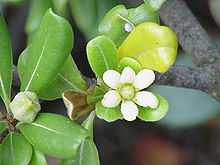 | |
| Flowering twig of Japanese Cheesewood (Pittosporum tobira) | |
| Scientific classification | |
| Kingdom: | Plantae |
| (unranked): | Angiosperms |
| (unranked): | Eudicots |
| (unranked): | Asterids |
| Order: | Apiales |
| Family: | Pittosporaceae |
| Genus: | Pittosporum Banks ex Sol. |
| Species | |
|
About 200, see text | |
| Synonyms | |
|
Citriobatus A.Cunn. ex Putt. | |
Pittosporum (/pɪˈtɒspɵrəm/ or /ˌpɪtɵˈspɔərəm/)[1] is a genus of about 200 species of flowering plants in the family Pittosporaceae. The genus is probably Gondwanan in origin; its present range extends from Australasia, Oceania, eastern Asia and some parts of Africa. Citriobatus is usually included here, but might be a distinct (though closely related) genus. They are commonly known as pittosporums or, more ambiguously, "cheesewoods".
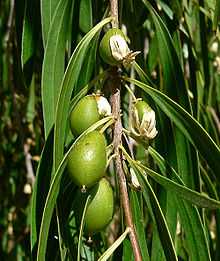
The species are trees and shrubs growing to 2–30 m tall. The leaves are spirally arranged or whorled, simple, with an entire or waved (rarely lobed) margin. The flowers are produced singly or in umbels or corymbs, each flower with five sepals and five petals; they are often sweetly scented. The fruit is a woody seed capsule, which bursts on ripening to release the numerous seeds. The seeds are coated with a sticky resinous substance. The genus is named after their sticky seeds, from the Greek meaning "pitch-seed".
Tarata (P. eugenioides) and Kohuhu (P. tenuifolium) – both from New Zealand – and the Japanese Cheesewood (P. tobira) from southern Japan are widely cultivated as ornamental plants in subtropical regions; pittosporums can also be grown indoors as bonsai. The petroleum nut (P. resiniferum) yields petroleum nut oil, which is sometimes proposed as biofuel; due to its excessive n-heptane content and consequent low octane rating, it is better suited as a source of n-heptane, which is otherwise produced from crude oil.
Many herbivores detest the resinuous pittosporums, in particular their seeds, which will stick anywhere. But some animals eat them with relish, for example the Kea (Nestor notabilis), which likes P. anomalum fruit and seeds. The Cottony Cushion Scale (Icerya purchasi) is a common pest on ornamental pittosporums (in particular the New Zealand species); the sac fungus Nectriella pironii often infects Japanese Cheesewood.
Selected species
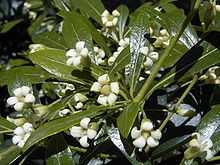
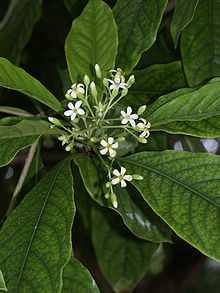
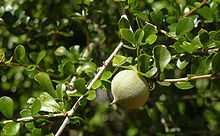

- Pittosporum aliferum
- Pittosporum angustifolium
- Pittosporum anomalum Laing & Gourlay
- Pittosporum arborescens Rich ex A.Gray
- Pittosporum argentifolium – Hōʻawa
- Pittosporum artense
- Pittosporum bicolor
- Pittosporum bracteolatum
- Pittosporum brevispinum
- Pittosporum ceylanicum
- Pittosporum collinum
- Pittosporum confertiflorum A.Gray – Hōʻawa (Hawaii)[2]
- Pittosporum coriaceum
- Pittosporum crassifolium – Karo
- Pittosporum dallii
- Pittosporum daphniphylloides
- Pittosporum ellipticum
- Pittosporum ellipticum ssp. serpentinum
- Pittosporum eriocarpum
- Pittosporum erioloma C.Moore & F.Muell.
- Pittosporum eugenioides – Tarata, "lemonwood"
- Pittosporum fairchildii
- Pittosporum ferrugineum
- Pittosporum gatopense
- Pittosporum glabrum – Hōʻawa
- Pittosporum goetzei
- Pittosporum gomonenense
- Pittosporum heterophyllum
- Pittosporum illicioides
- Pittosporum kirkii – Kirk's Pittosporum, Kirk‟s kōhūhū, thick-leaved kohukohu
- Pittosporum lancifolium
- Pittosporum ligustrifolium
- Pittosporum linearifolium
- Pittosporum moluccanum
- Pittosporum multiflorum
- Pittosporum muricatum
- Pittosporum napaliense
- Pittosporum nativitatis
- Pittosporum obcordatum – Heart-leaved Kohuhu
- Pittosporum oreillyanum – O'Reilly's Pittosporum
- Pittosporum ornatum
- Pittosporum orohenense
- Pittosporum paniense
- Pittosporum parvifolium
- Pittosporum patulum
- Pittosporum pauciflorum
- Pittosporum pentandrum
- Pittosporum phillyraeoides – Weeping Pittosporum, Willow Pittosporum, Butterbush, Native Apricot
- Pittosporum pickeringii
- Pittosporum raivavaeense
- Pittosporum rapense
- Pittosporum resiniferum – Petroleum Nut
- Pittosporum revolutum – Rough-fruited Pittosporum, Wild Yellow Jasmine, Yellow Pittosporum, Brisbane Laurel
- Pittosporum rhombifolium – Queensland Pittosporum, Diamond Pittosporum, "hollywood", now Auranticarpa rhombifolia.
- Pittosporum rhytidocarpum
- Pittosporum rubiginosum
- Pittosporum silamense
- Pittosporum spinescens (F.Muell.) L.Cayzer, Crisp & I.Telford
- Pittosporum stenophyllum
- Pittosporum taitense
- Pittosporum tanianum
- Pittosporum tenuifolium – Kohuhu, Kohukohu, Black Matipo
- Pittosporum terminalioides
- Pittosporum tobira – Japanese Cheesewood, Japanese Mock Orange
- Pittosporum trilobum
- Pittosporum turneri
- Pittosporum undulatum – Sweet Pittosporum, Australian Cheesewood, Native Daphne, "Mock Orange"
- Pittosporum venulosum F.Muell.
- Pittosporum virgatum
- Pittosporum viridulatum
- Pittosporum viridiflorum Sims
- Pittosporum viscidum
- Pittosporum wingii F.Muell.
- Pittosporum yunckeri A.C.Sm.
References
- ↑ The first pronunciation is that expected for Anglo-Latin; the second is common in nurseries. Sunset Western Garden Book, 1995:606–607
- ↑ Little Jr., Elbert L.; Roger G. Skolmen (1989). "Hōʻawa" (PDF). Common Forest Trees of Hawaii (Native and Introduced). United States Forest Service. Retrieved 2010-02-07.
External links
| Wikimedia Commons has media related to Pittosporum. |
- A.J. Townsend (1999). "Pittosporum patulum recovery plan, 1999-2009" (PDF). Department of Conservation, Wellington, New Zealand. Retrieved 2007-04-18.